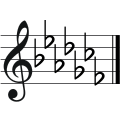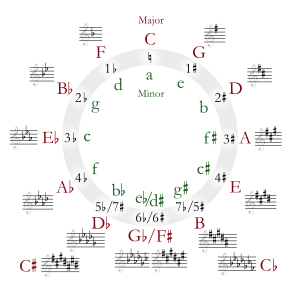A-flat minor facts for kids
 |
||
| Relative key | C♭ major | |
|---|---|---|
| Parallel key | A♭ major | |
| Notes in this scale | ||
| A♭, B♭, C♭, D♭, E♭, F♭, G♭, A♭ | ||
A-flat minor is a minor scale in music that starts on the note A-flat. Think of a scale as a set of musical notes played in order, like going up or down a ladder. This particular scale has a special "key signature" with seven flats. A flat sign means you play a note a tiny bit lower than its usual sound.
Every musical key has a relative major key that shares the same key signature. For A-flat minor, its relative major is C-flat major. It also has a parallel major key, which starts on the same note but sounds brighter; this is A-flat major. A-flat minor also has an enharmonic equivalent, which means it sounds exactly the same but is written differently. Its enharmonic equivalent is G-sharp minor.
Contents
Why A-flat Minor is Not Often Used
A-flat minor is not very common as the main key for a piece of music. This is because it has seven flats in its key signature, which can be tricky to read and play.
Often, if a composer wants to write music that sounds like A-flat minor, they will use its enharmonic equivalent, G-sharp minor, instead. G-sharp minor has only five sharps in its key signature, which is much simpler to read and play than seven flats. Because of this, you won't find many famous pieces written entirely in A-flat minor.
Sometimes, when A-flat minor is used, especially in older music, the way its key signature is written in the bass clef might look a little different. The flat for the F note might be placed on a different line than you'd expect.
A-flat Minor in Classical Music
Even though it's rare, A-flat minor does appear in some classical music pieces. Here are a few examples:
- The Funeral March in Ludwig van Beethoven's Piano Sonata No. 12, Op. 26.
- A part of the last movement of Beethoven's Piano Sonata No. 31, Op. 110. (This section uses six flats, not the full seven).
- Johannes Brahms wrote a Fugue for organ around 1857 in this key.
- Max Bruch's Concerto for Two Pianos and Orchestra, Op. 88a. (Some versions of this piece also use a six-flat signature).
- The "Evocación" from Book I of Isaac Albéniz's Iberia.
- Leoš Janáček used it for his violin sonata and a solo organ part in his Glagolitic Mass.
- Moritz Moszkowski used it for his piano étude, opus 72 number 13.
- Also, the Polonaise in A-Flat Minor by Frédéric Chopin.
A-flat Minor in Popular Music
A-flat minor also shows up in some popular songs and musicals:
- In Frederick Loewe's music for the 1956 musical play My Fair Lady, the "Second Servants' Chorus" is set in A-flat minor.
- Another example is the song "Walkin' on the Sun" by the band Smash Mouth.
Scales and Keys
| Diatonic Scales and Keys | |||||||||||||||||||||||||||||||||||||||||||||||||||||||
|---|---|---|---|---|---|---|---|---|---|---|---|---|---|---|---|---|---|---|---|---|---|---|---|---|---|---|---|---|---|---|---|---|---|---|---|---|---|---|---|---|---|---|---|---|---|---|---|---|---|---|---|---|---|---|---|
|
|||||||||||||||||||||||||||||||||||||||||||||||||||||||
| The table shows the number of sharps or flats in each scale. Minor scales are written in lower case. | |||||||||||||||||||||||||||||||||||||||||||||||||||||||
See also
 In Spanish: La bemol menor para niños
In Spanish: La bemol menor para niños


